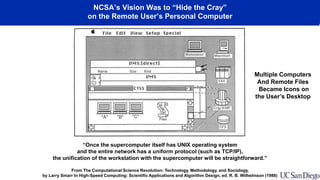Supercomputing from the Desktop Workstation
- 1. “Supercomputing from the Desktop Workstation” Invited Zoom Presentation Internet Reunion Club, Sponsored by Internet2 “Using the Internet (1983-1992)” June 7, 2022 Dr. Larry Smarr Founding Director Emeritus, California Institute for Telecommunications and Information Technology; Distinguished Professor Emeritus, Dept. of Computer Science and Engineering Jacobs School of Engineering, UCSD http://lsmarr.calit2.net
- 2. Abstract Computational physics drove NSF to create an Office of Advanced Scientific Computing. Within 2 years (1984-86) the Macintosh, NSF Supercomputer Centers, and NSFnet appeared. I will explore their essential interactions and show how the networked personal computer software used to interpret supercomputer output led directly to NSCA Mosaic and the explosion of the WWW.
- 3. Supercomputing Always Assumed Visualization by a User’s Workstation “In the early days, von Neumann said digital computers would generate so much data that it would overwhelm the human mind and so we needed to turn the data stream flowing from the computer into a visualization by running the output of the computer into an oscilloscope. So this idea was there from the very beginning, but NCSA took it to a whole another level.” - Larry Smarr in HPCWire Article by John Russell, September 20, 2016 www.hpcwire.com/2016/09/20/larry-smarr-helps-ncsa-celebrate-30th-anniversary/
- 4. 1972-1985: My Early Computational Astrophysics Research Made Essential Use of Visualization of the Supercomputer’s Output I Spent a Decade Supercomputing at LLNL (with Jim Wilson) and Then at The Max Planck Institute for Physics and Astrophysics (with Mike Norman and Karl-Heinz Winkler) Gas Accretion Onto a Black Hole With Wilson and Hawley 1982 Cosmic Jets Emerging From Galactic Centers With Norman and Winkler 1981 Gravitational Radiation From Black Hole Collisions With Eppley 1978
- 5. 1981 NSF’s Press Report: “Distribution of Balanced Computational Capacity at the Local Nodes is as Important as the Provision of Maximum Capability of the Principal Node” • The Local Nodes Make Possible Modes of Operation and Scientific Investigations Not Possible via Remote Acess to the Central Node • A Local Node Also Provides for Much Higher I/O Rates to the User than can be Provided with Remote Access to a Central Facility • Any Commitment to Increased Computational Resources Must be Accompanied by an Expansion of Graphics Facilities to Help Manage the Increased Data Flow www.nr.com/whp/NSFCompPhys1981.pdf 1981 Subcommittee Members Included: • Ken Wilson • Steven Orszag • Larry Smarr All Became NSF Supercomputer Center Directors in 1985
- 6. 1981-1984: IBM PC and Apple Macintosh Introduced, Vastly Expanding Local Nodes for Remote Users
- 7. 1982-83: Documenting The Unmet Supercomputing Needs of A Broad Range of Disciplines Led to the NCSA Proposal to NSF 1982 1983 http://lsmarr.calit2.net/supercomputer_famine_1982.pdf http://lsmarr.calit2.net/Black_Proposal.pdf
- 8. 1985: NSF OASC Adopted DOE’s High-Performance Computing Models In Creating Two of the Five New Academic Supercomputing Centers NCSA Was Modeled on LLNL SDSC Was Modeled on MFEnet 1985
- 9. 1985: NSF Supercomputer Center Directors Ken Wilson and I Testified to Congress, but SuperNetworks Were Just as Important “We ought to consider a national initiative to build interstate highways for information with a fiber optics network connecting the major computational centers in this country” -Senator Al Gore “The University of Illinois will be experimenting with fiber optic ‘information flow pipes,’ which promise to be able to reach billions of bits per second.” -NCSA Director Larry Smarr http://lsmarr.calit2.net/hrg-1985-tec- 0068_from_1_to_806_s.pdf 1985
- 10. 1986-88: Launching the Nation’s Information Infrastructure - NSFnet Supernetwork and the Six NSF Supercomputers NSFNET 56 Kb/s Backbone (1986-8) NCSA PSC NCAR CTC JVNC SDSC NSF’s Dennis Jennings Adopts TCP/IP Source: Jim Bottum
- 11. 1986: NCSA Telnet Enabled Local Nodes to Network to Central Supercomputer Nodes • NCSA Telnet -- Interactive Access – From Macintosh or PC Computer – To Telnet Hosts on TCP/IP Networks • Allows for Simultaneous Connections – To Numerous Computers on The Net – Standard File Transfer Server (FTP) – Enables Users to Transfer Files to and from Remote Machines Professor John Kogut Simulating Quantum Chromodynamics He Uses a Mac - The Mac Uses the Cray Source: Larry Smarr 1986 Data Generator Data Portal Data Transmission
- 12. NCSA’s Vision Was to “Hide the Cray” on the Remote User’s Personal Computer “Once the supercomputer itself has UNIX operating system and the entire network has a uniform protocol (such as TCP/IP), the unification of the workstation with the supercomputer will be straightforward.” From The Computational Science Revolution: Technology, Methodology, and Sociology, by Larry Smarr In High-Speed Computing: Scientific Applications and Algorithm Design, ed. R. B. Wilhelmson (1988) Multiple Computers And Remote Files Became Icons on the User’s Desktop
- 13. Researchers Used Desktop Software to Plan the Integration of Their PC/Workstation, Across Multiple Networks, to Central Supercomputers From The Computational Science Revolution: Technology, Methodology, and Sociology, by Larry Smarr In High-Speed Computing: Scientific Applications and Algorithm Design, ed. R. B. Wilhelmson (1988)
- 14. 1990-91: NCSA Collage-a Synchronous Desktop Collaboration Tool For Sharing Mac, PC, and UNIX Desktops Across the Network Led to NCSA Mosaic Source: Susan Hardin, NCSA
- 15. 1993-94: NCSA Mosaic Induces Exponential Growth of Clients Coupling to Servers Across the Network MBytes Transferred over NSF Backbone per Month Mosaic Induces 10,000-Fold Increase in WWW Traffic!!














